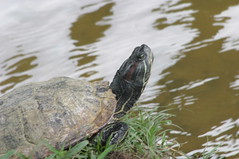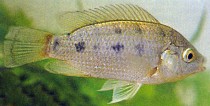Stowaways
These are species that were transported into their nonnative habitats by accident. They get a free passage unnoticed by humans because of their small size and inconspicuous nature. The most common animals that have been circulated throughout the Earth are also the ones that cause the greatest losses in capital and extinction of species – the rats (Hunter, 2002). Disease organisms can also take a free ride on the bodies of travellers, typified by the European explorers centuries ago and even the SARS carriers that arrived on the shores of Singapore recently (Fleischauer, 2003). With the development of a seamless worldwide transportation system, this form of alien introduction could become ever more common and a much greater challenge to control.
Commerce and Subsistence
This is the deliberate introduction of species into an area for food and farming. The Polynesians who first inhabited the Hawaiian archipelago were one of the earliest to practise this form of introduction. Following that, the European colonists in the 1778 arrived with more animal species, including rats, goats, cattle, the domestic cat, the Indian mongoose as well the barn owl (Primack, 1998). This form of transportation also occurs in the other direction. As colonists send their ships back for more supplies, organisms from the colonized lands hop on and are also transported to other parts of the world.
Recreation
Although game hunting is not allowed in Singapore, the introduction of exotic mammals, game birds, game fish and smaller fish as food for the game fish has been an important source of alien species for many western countries. More than 50 mammalian species has been introduced into the Texas ranches to allow game hunters to hunt for nonnative mammals without having to travel beyond Texas (Bolen and Robinson, 1999). Fishing, despite being a popular pastime in Singapore, has not led to the large-scale introduction of exotic game fish by anglers as is occurring in the U.S., since it is against the law to release animals into the wild. Under the National Parks Act (Cap. 198A), any person found bringing any animal and releasing it into a nature reserve can be fined up to S$10,000.
Pet and Wildlife Trade
Pet keeping is an activity that is enjoying an increase in popularity. In Singapore, there are rules and regulations to ensure responsible pet ownership and to prevent the endangering of wild animals. Under the Wild Animals and Birds Act (Cap. 351), wild animals and birds are not allowed to be killed, caught or kept. Importation of wild animals and birds are also illegal in Singapore. The animals that can be kept as pets, as listed by the Agri-Food and Veterinary Authority (AVA) in its website, are dogs, cats, rabbits, guinea pigs, hamsters, gerbils, mice, chinchillas, red-eared sliders, and many types of birds and fish. However, there still exist many cases of wild animals being kept illegally. One of the recent ones was a student who kept 22 wild and endangered species in his home. The collection included of pythons, other assorted reptiles, and even mammals known as sugar gliders. The offender was fined S$5,600 (Straits Times, 13th April 2004).
These exotic species, if released into the wild, can cause devastating effects. An example is seen in several U.S. states, where numerous species of the voracious snakehead fish have, over the last few years, been terrorizing the inland waters. These exotic pets were easily available and their ability to wriggle short distances on land means that they could invade many aquatic habitats quickly (Bergguist, 2003; Miller, 2002; Watson, 2002). In Singapore, the highly popular luohan (flowerhorn cichlid) trade and hobby could lead to similar effects if these aquatic pets are released into local waters, either by accident or on purpose, as some environmentalists fear (Ng, 2002). Presently, the compassionate release of animals by religious groups has been a source of alien introductions in Singapore. Every year, many Buddhists and Taoists mark Vesak Day by releasing turtles, fish and birds at temples, inland waters, parks and beaches as a symbolic act of repentance, though illegally (Dawn Tan, 1995; Joann Tan, 2004; Wee, 2001). Under the National Parks Act (Cap. 198A), any person found bringing any animal and releasing it into a nature reserve can be fined up to S$10,000.
Research and Biological Control
Scientists may keep living specimens in their laboratories for biological research and these species may escape into the wild, and sometimes even into areas which are not in their native ranges (Carlton, 1989). At this age when gene alterations techniques are used intensively in research laboratories, such accidental introductions may pose an even greater danger to the ecosystem.
Exotic species may also be deliberately introduced by scientists to control other exotic species that are already present due to other factors. Although this is considered a salvage method, there are cases where this has led to success in the control of exotic species. This method of biological control involves the searching of a predator of the exotic species in its native range and introducing this exotic predator into the area where the alien species has been causing harm to the ecosystem (DeBach and Rosen, 1990). However, backlash may also result if such introductions are inadequately planned and managed. Euglandina rosea, predators of the introduced giant African snail in Moorea, an island in the southern Pacific, were brought into the island to control the African snail, but unfortunately, the African snails were not affected. Instead, 7 native species of viviparous tree snails were decimated by the introduced predators as they found easier prey in the former (Cowie, 1992; Murray et al., 1988).
Environmental Factors
In some instances, species may expand their ranges or move into an area in which they would become exotics because of changes in the environment (Hunter, 2002). Such changes can possibly be a result of human activities. The clearing of the forests in the eastern part of the United States for agriculture may have led to many plant and animal species moving in from the western part of the country as they are now allowed to expand their ranges eastwards (Brothers, 1992). The global climate is also a crucial factor in determining the geographical range of species. Changes in the global temperatures in recent years, especially of the warming trends, have caused expansion in the range of many species (Crozier, 2003; Lingren et al., 2000; Thomas et al., 2001). This can eventually lead to exotic species appearing at the range margins as global temperatures continue to rise. The amount of global warming that is attributable to human activities is, however, still an ongoing debate.



